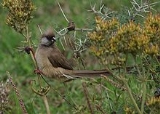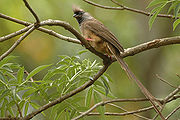
Speckled Mousebird
Encyclopedia

Species
In biology, a species is one of the basic units of biological classification and a taxonomic rank. A species is often defined as a group of organisms capable of interbreeding and producing fertile offspring. While in many cases this definition is adequate, more precise or differing measures are...
of mousebird
Mousebird
The mousebirds are a small group of birds which have no known close affinities to other groups, though they and the parrots and cockatoos may be closer to each other than to other birds. The mousebirds are therefore given order status as Coliiformes...
, as well as one of the most common.
Description
This bird is about 35 cm (14 inches) long, with the tail comprising approximately half the length, and weighs about 57 grams (2 oz). It is well-named, because it is dull-mousy brown in overall color on the back and on the head (including a prominent crest). The billBeak
The beak, bill or rostrum is an external anatomical structure of birds which is used for eating and for grooming, manipulating objects, killing prey, fighting, probing for food, courtship and feeding young...
is black on the upper part and is a pinkish color on the lower part. The rare White-headed Mousebird
White-headed Mousebird
The White-headed Mousebird is a bird belonging to the mousebird family, Coliidae. It is found only in east Africa where it occurs in southern Somalia and parts of Kenya with its range just extending into southern Ethiopia and northern Tanzania...
can be confused with this species, but the differently colored mandibles and the lack of a bare grey orbital patch render the Speckled species distinctive.
The Speckled Mousebird is not known for its voice, as songbirds are, although it is a noisy creature. They make a warbling tsu-tsu call while in flight, and are known for their tisk-tisk alarm call while in flight.
Range and habitat
It is distributed from CameroonCameroon
Cameroon, officially the Republic of Cameroon , is a country in west Central Africa. It is bordered by Nigeria to the west; Chad to the northeast; the Central African Republic to the east; and Equatorial Guinea, Gabon, and the Republic of the Congo to the south. Cameroon's coastline lies on the...
east to Eritrea
Eritrea
Eritrea , officially the State of Eritrea, is a country in the Horn of Africa. Eritrea derives it's name from the Greek word Erethria, meaning 'red land'. The capital is Asmara. It is bordered by Sudan in the west, Ethiopia in the south, and Djibouti in the southeast...
and Ethiopia
Ethiopia
Ethiopia , officially known as the Federal Democratic Republic of Ethiopia, is a country located in the Horn of Africa. It is the second-most populous nation in Africa, with over 82 million inhabitants, and the tenth-largest by area, occupying 1,100,000 km2...
, south through eastern Africa
Africa
Africa is the world's second largest and second most populous continent, after Asia. At about 30.2 million km² including adjacent islands, it covers 6% of the Earth's total surface area and 20.4% of the total land area...
to southern South Africa
South Africa
The Republic of South Africa is a country in southern Africa. Located at the southern tip of Africa, it is divided into nine provinces, with of coastline on the Atlantic and Indian oceans...
. Most habitats are suitable for this species, except the rainforest
Rainforest
Rainforests are forests characterized by high rainfall, with definitions based on a minimum normal annual rainfall of 1750-2000 mm...
s and more arid areas. This mousebird prefers open bushveld habitats. It is widespread in savanna
Savanna
A savanna, or savannah, is a grassland ecosystem characterized by the trees being sufficiently small or widely spaced so that the canopy does not close. The open canopy allows sufficient light to reach the ground to support an unbroken herbaceous layer consisting primarily of C4 grasses.Some...
and open woodlands, as well as areas with tangled thickets. It is a common "backyard bird", often seen in urban areas that contain gardens and orchards.
Ecology
The Speckled Mousebird is a frugivore which subsists on fruitFruit
In broad terms, a fruit is a structure of a plant that contains its seeds.The term has different meanings dependent on context. In non-technical usage, such as food preparation, fruit normally means the fleshy seed-associated structures of certain plants that are sweet and edible in the raw state,...
s, berries, leaves
Leaf
A leaf is an organ of a vascular plant, as defined in botanical terms, and in particular in plant morphology. Foliage is a mass noun that refers to leaves as a feature of plants....
, seed
Seed
A seed is a small embryonic plant enclosed in a covering called the seed coat, usually with some stored food. It is the product of the ripened ovule of gymnosperm and angiosperm plants which occurs after fertilization and some growth within the mother plant...
s and nectar, and is fairly catholic
Catholic
The word catholic comes from the Greek phrase , meaning "on the whole," "according to the whole" or "in general", and is a combination of the Greek words meaning "about" and meaning "whole"...
in its choice of food from area to area.
These are conspicuously social birds, feeding together and engaging in mutual preening. They also accompany each other when they go to ground to dust bathe (also to occasionally to swallow pebbles to assist in grinding up vegetation as they digest it). Upon nightfall, they roost in very tight groups of 20 or so birds and on cold nights they can become torpid. Being in a torpid state could make them easy prey, but the large groups are apparently effective enough to deter most nocturnal predators.

